Themed collection Most popular 2021 analytical chemistry articles, 2021

DNA nanostructure-based nucleic acid probes: construction and biological applications
In recent years, DNA has been widely noted as a kind of material that can be used to construct building blocks for biosensing, in vivo imaging, drug development, and disease therapy because of its advantages of good biocompatibility and programmable properties.

Chem. Sci., 2021,12, 7602-7622
https://doi.org/10.1039/D1SC00587A
Fluorescent small organic probes for biosensing
Small-molecule based fluorescent probes are increasingly important for the detection and imaging of biological signaling molecules due to their simplicity, high selectivity and sensitivity, whilst being non-invasive, and suitable for real-time analysis of living systems.
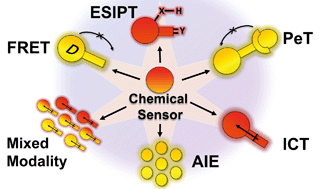
Chem. Sci., 2021,12, 3406-3426
https://doi.org/10.1039/D0SC06928K
Near-infrared fluorescent molecular probes for imaging and diagnosis of nephro-urological diseases
Near-infrared fluorescent molecular probes with improved imaging depth and optimized biodistribution have been reviewed, showing great potential for diagnosis of nephro-urological diseases.
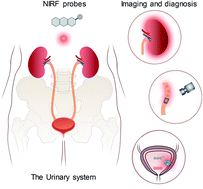
Chem. Sci., 2021,12, 3379-3392
https://doi.org/10.1039/D0SC02925D
Activatable fluorescence sensors for in vivo bio-detection in the second near-infrared window
Fluorescence imaging in the second near-infrared (NIR-II, 1000–1700 nm) window has exhibited advantages of high optical resolution at deeper penetration (ca. 5–20 mm) in bio-tissues owing to the reduced photon scattering and tissue autofluorescence.
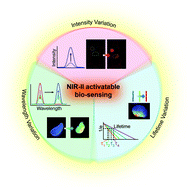
Chem. Sci., 2021,12, 3448-3459
https://doi.org/10.1039/D0SC04789A
Near-infrared fluorescent probes: a next-generation tool for protein-labeling applications
This minireview describes the development of NIR chemical probes for various protein-tag systems.
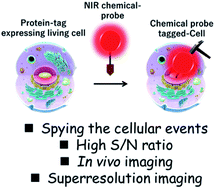
Chem. Sci., 2021,12, 3437-3447
https://doi.org/10.1039/D0SC04792A
Structural and process controls of AIEgens for NIR-II theranostics
Structural and process controls of NIR-II AIEgens realize manipulating of radiative (R) and nonradiative (NR) decay for precise theranostics.
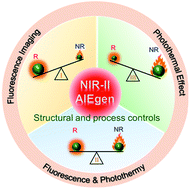
Chem. Sci., 2021,12, 3427-3436
https://doi.org/10.1039/D0SC02911D
Enzyme-activatable fluorescent probes for β-galactosidase: from design to biological applications
This review highlights the molecular design strategy of β-galactosidase-activatable probes from turn-on mode to ratiometric mode, from ACQ to AIE-active probes, from NIR-I to NIR-II imaging and dual-mode of chemo-fluoro-luminescence imaging.
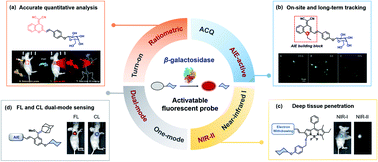
Chem. Sci., 2021,12, 9885-9894
https://doi.org/10.1039/D1SC02069B
CRISPR technology incorporating amplification strategies: molecular assays for nucleic acids, proteins, and small molecules
Clustered Regularly Interspaced Short Palindromic Repeats (CRISPR) and CRISPR-associated (Cas) protein systems revolutionize genome engineering and advance analytical chemistry and diagnostic technology.
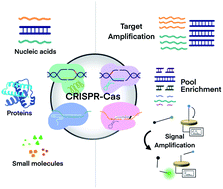
Chem. Sci., 2021,12, 4683-4698
https://doi.org/10.1039/D0SC06973F
Phosphorescent metal complexes as theranostic anticancer agents: combining imaging and therapy in a single molecule
The recent development in phosphorescent iridium, ruthenium and rhenium complexes as theranostic anticancer agents is summarized.
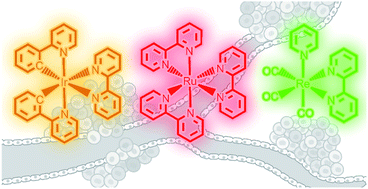
Chem. Sci., 2021,12, 2357-2367
https://doi.org/10.1039/D0SC06885C
The chronological evolution of small organic molecular fluorescent probes for thiols
The chronological evolution of small organic molecular fluorescent probes for thiols: from separation dependency analysis to cellular specific analysis, what's next?
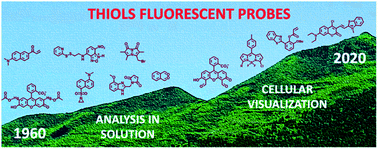
Chem. Sci., 2021,12, 1220-1226
https://doi.org/10.1039/D0SC04960C
HSA-Lys-161 covalent bound fluorescent dye for in vivo blood drug dynamic imaging and tumor mapping
HSA lysine-161 covalent bound quinoxaline–coumarin based fluorescent dye realized in situ blood drug concentration monitoring and tumor visualization.
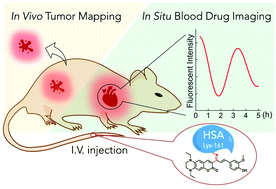
Chem. Sci., 2022,13, 218-224
https://doi.org/10.1039/D1SC05484H
Enzyme-activated near-infrared fluorogenic probe with high-efficiency intrahepatic targeting ability for visualization of drug-induced liver injury
We rationally designed a leucine aminopeptidase (LAP) activated fluorogenic probe hCy-CA-LAP with high hepatocyte-targeting ability for accurate and sensitive imaging of DILI.
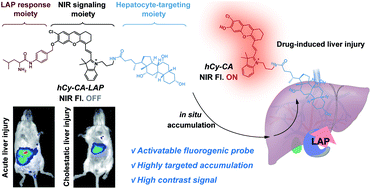
Chem. Sci., 2021,12, 14855-14862
https://doi.org/10.1039/D1SC04825B
Systematic investigation of the aza-Cope reaction for fluorescence imaging of formaldehyde in vitro and in vivo
Systematic investigation of various homoallylamines reveals N-p-methoxybenzyl homoallylamine as the optimal 2-aza-Cope reaction moiety for development of highly efficient formaldehyde fluorescent probes for in vitro and in vivo imaging.
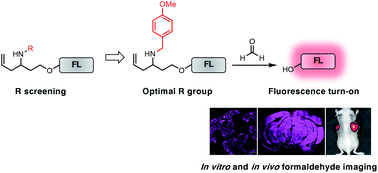
Chem. Sci., 2021,12, 13857-13869
https://doi.org/10.1039/D1SC04387K
Stress response decay with aging visualized using a dual-channel logic-based fluorescent probe
Rather than tracking aging using the resting state, ROKS, an optical probe, was developed for evaluating the degree of aging dynamically by precisely monitoring the stress response of individuals under stress.

Chem. Sci., 2021,12, 13483-13491
https://doi.org/10.1039/D1SC04162B
Genetic encoding of a highly photostable, long lifetime fluorescent amino acid for imaging in mammalian cells
Acridonylalanine (Acd) is photostable, with a high quantum yield and long fluorescence lifetime in water. An evolved tRNA synthetase (RS) enables genetic incorporation of Acd in mammalian cells and its use in fluorescence lifetime imaging microscopy.

Chem. Sci., 2021,12, 11955-11964
https://doi.org/10.1039/D1SC01914G
Turning waste into wealth: facile and green synthesis of carbon nanodots from pollutants and applications to bioimaging
The pollutant reactive red 2 was employed to synthesize fluorescent carbon nanodots allowing biological imaging in vitro and in vivo.

Chem. Sci., 2021,12, 11722-11729
https://doi.org/10.1039/D1SC02837E
Activation of apoptosis by rationally constructing NIR amphiphilic AIEgens: surmounting the shackle of mitochondrial membrane potential for amplified tumor ablation
In this contribution, based on a “step-by-step” molecular design strategy, a novel NIR amphiphilic AIEgen TPA-S-TPP with a triplet lifetime of 11.43 μs and surmounting the shackle of MMP was successfully fabricated for amplified tumor ablation.
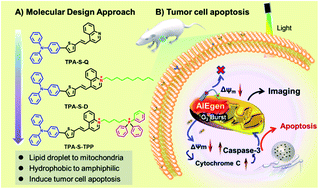
Chem. Sci., 2021,12, 10522-10531
https://doi.org/10.1039/D1SC02227J
NIR-II cell endocytosis-activated fluorescent probes for in vivo high-contrast bioimaging diagnostics
A Cell Endocytosis-Activated Fluorescent (CEAF) probe triggered by disaggregation and protonation is designed for high contrast in vivo bioimaging and diagnostics in the second near-infrared window (1000–1700 nm).

Chem. Sci., 2021,12, 10474-10482
https://doi.org/10.1039/D1SC02763H
Strategic engineering of alkyl spacer length for a pH-tolerant lysosome marker and dual organelle localization
A series naphthalimide-based fluorophores were designed by alkyl spacer length engineering to discover a pH-tolerant lysosomal marker. This approach also allows to probe lysosome-related organelles in C. elegans and communication between organelles.
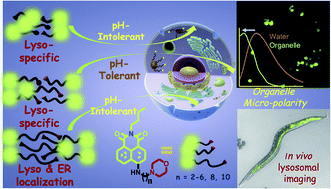
Chem. Sci., 2021,12, 9630-9644
https://doi.org/10.1039/D1SC00542A
Translating daily COVID-19 screening into a simple glucose test: a proof of concept study
COVID-19 glucose test: translating SARS-CoV-2 detection into a glucose test is achieved by incorporating target-responsive rolling circle amplification and a CRISPR-based collateral cleavage module with a portable glucose meter.
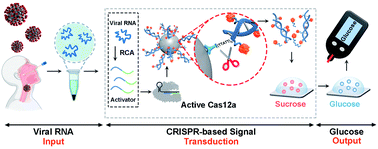
Chem. Sci., 2021,12, 9022-9030
https://doi.org/10.1039/D1SC00512J
X-ray scattering reveals ion clustering of dilute chromium species in molten chloride medium
Ion clustering of dilute chromium species was unexpectedly revealed in a high-temperature molten chloride salt, challenging several long-held assumptions regarding specific ionic interactions and transport in molten ionic media.
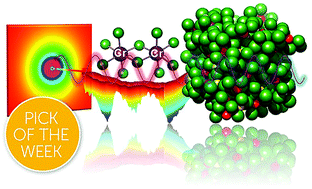
Chem. Sci., 2021,12, 8026-8035
https://doi.org/10.1039/D1SC01224J
Late-stage functionalisation of alkyne-modified phospha-xanthene dyes: lysosomal imaging using an off–on–off type of pH probe
A series of NIR-emissive phospha-xanthene dyes bearing an ethynyl group are reported. The late-stage functionalisation of the NIR dyes enables creation of multi-functionalised fluorescent probes that can be designed to target organelles of interest.

Chem. Sci., 2021,12, 7902-7907
https://doi.org/10.1039/D1SC01705E
Synthesis of an AIEgen functionalized cucurbit[7]uril for subcellular bioimaging and synergistic photodynamic therapy and supramolecular chemotherapy
An AIEgen-functionalized cucurbit[7]uril was synthesized for the first time and spontaneously self-assembled into nanoaggregates in aqueous solutions and allowed subcellular imaging of the lysosome and photodynamic therapy and chemotherapy of cancer.
![Graphical abstract: Synthesis of an AIEgen functionalized cucurbit[7]uril for subcellular bioimaging and synergistic photodynamic therapy and supramolecular chemotherapy](/en/Image/Get?imageInfo.ImageType=GA&imageInfo.ImageIdentifier.ManuscriptID=D1SC01139A&imageInfo.ImageIdentifier.Year=2021)
Chem. Sci., 2021,12, 7727-7734
https://doi.org/10.1039/D1SC01139A
Rapid and ultrasensitive electrochemical detection of circulating tumor DNA by hybridization on the network of gold-coated magnetic nanoparticles
This study introduces a new electrochemical sensing strategy for the rapid detection of circulating tumor DNA (ctDNA) from whole blood in combination with a network of DNA-Au@MNPs with high sensitivity and excellent selectivity.
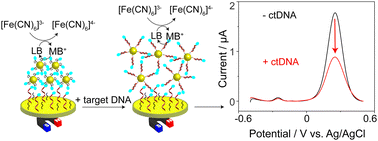
Chem. Sci., 2021,12, 5196-5201
https://doi.org/10.1039/D1SC01044A
Design and synthesis of a ratiometric photoacoustic imaging probe activated by selenol for visual monitoring of pathological progression of autoimmune hepatitis
A ratiometric photoacoustic imaging probe activated by selenol was developed for visual monitoring of pathological progression of autoimmune hepatitis.
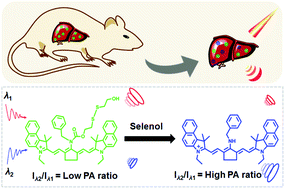
Chem. Sci., 2021,12, 4883-4888
https://doi.org/10.1039/D0SC06573K
Hierarchical dynamics in allostery following ATP hydrolysis monitored by single molecule FRET measurements and MD simulations
We report on a study that combines advanced fluorescence methods with molecular dynamics simulations to cover timescales from nanoseconds to milliseconds for a large protein, the chaperone Hsp90.
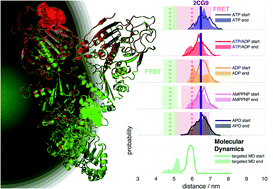
Chem. Sci., 2021,12, 3350-3359
https://doi.org/10.1039/D0SC06134D
Single-molecule fluorescence detection of a tricyclic nucleoside analogue
Fluorescent nucleoside analogue ABN is readily detected at the single-molecule level and retains a quantum yield >50% in duplex DNA oligonucleotides.
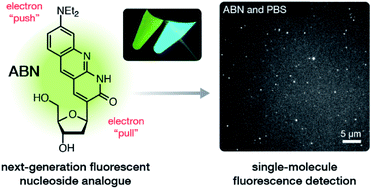
Chem. Sci., 2021,12, 2623-2628
https://doi.org/10.1039/D0SC03903A
Accelerated reactions of amines with carbon dioxide driven by superacid at the microdroplet interface
Microdroplets display distinctive interfacial chemistry, manifested as accelerated reactions relative to those observed for the same reagents in bulk.
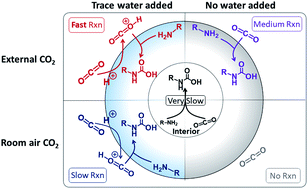
Chem. Sci., 2021,12, 2242-2250
https://doi.org/10.1039/D0SC05625A
Purely organic light-harvesting phosphorescence energy transfer by β-cyclodextrin pseudorotaxane for mitochondria targeted imaging
A new type of purely organic light-harvesting PET supramolecular assembly is constructed with efficient energy transfer and ultrahigh antenna effect. Moreover, the assembly could be used for mitochondria targeted imaging in A549 cancer cells.
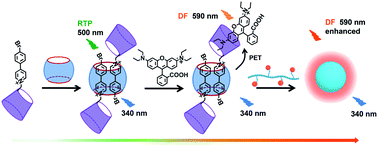
Chem. Sci., 2021,12, 1851-1857
https://doi.org/10.1039/D0SC05343K
All-in-one mitochondria-targeted NIR-II fluorophores for cancer therapy and imaging
Small-molecule subcellular organelle-targeting theranostic probes are crucial for early disease diagnosis and treatment.

Chem. Sci., 2021,12, 1843-1850
https://doi.org/10.1039/D0SC04727A
About this collection
This specially curated collection pulls together some of the most popular articles from 2021 in the field of analytical chemistry. The collection presents some outstanding contributions to the field, ranging from fluorescent small organic probes for biosensing to electrochemical detection of circulating tumor DNA, and as with all Chemical Science articles – they are all completely free to access and read. We hope you enjoy browsing through this collection.
If a particular article has inspired you, do feel free to share on social media using the buttons on each article landing page and use our hashtag: #ChemSciMostPopular